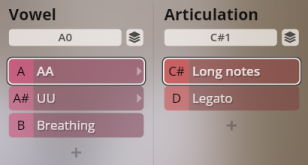SYNCHRON-ized Choir
Introduction
Welcome to the Vienna Symphonic Library’s series of Synchron Instruments! SYNCHRON-ized Vienna Choir is based on its Vienna Instruments namesake, and offers a completely overhauled sample database optimized for the Vienna Synchron Player. Our goal was to improve these ensemble’s playability and realism even more, which we achieved by enhancing the sample recordings as well as by utilizing the Synchron Player’s unique features.
About Preset
Synchron libraries generally offer different Presets according to how velocity is handled, arranged in separate folders.
“VelXF sus - MOD”: velocity crossfading is only activated for long notes, while the dynamics of short notes are controlled by keystroke velocity, thus facilitating phrasing.
“VelXF - MOD”: all articulations have velocity crossfading activated so that you can control dynamics with MIDI controller CC1, the modwheel.
“Velocity”: note volume is controlled by keystroke velocity just like a piano. Apart from that, velocity crossfading can always be enabled or disabled by clicking its on/off symbol in the Synchron Player's Perform tab.
Presets are subdivided into different articulation categories, including one named “Custom” and ready for your own creations. Within these articulation categories, you can select a type, e.g., normal or marcato, and for some of the types there are additional options available, such as normal/marcato crossfading. If you happen to be short of RAM, you can deactivate Articulations you do not need, and activate them again if necessary.
Switching between playing styles and articulations is generally done via dedicated keys on the keyboard and aptly called “keyswitches”. By default the keyswitches for Articulations are mapped starting from C1. Type keyswitches normally start from G1.
Dimension Controllers offer additional options within some Articulations or Types, most notably that of crossfading between different Patches. The controller function is indicated by the group’s respective caption, as of course it may take on different tasks as needed.
About Patches
Patches can be used to build your own custom Presets and adapt the Synchron Libraries to your specific requirements. For further information on constructing Presets, please see the Synchron Player manual.
Mixer Presets
For each instrument, there are a number of Mixer Presets that depict different recording situations. The basic Mixer Presets are Close, Classic, Distant, short and long Reverb without convolution, and MIR unprocessed; others (e.g., different positioning in the hall) may be added according to voice.
About Pitch
For designating pitch, the Vienna Symphonic Library uses International Pitch Notation (IPN), which was agreed upon internationally under the auspices of the Acoustical Society of America. In this system the international standard of A=440 Hz is called A4 and middle C is C4. All pitches are written as capital letters, their respective octave being indicated by a number next to it. The lowest C on the piano is C1 (the A below that is A0), etc.
The Synchron Player software allows you to set middle C to C3, C4, or C5 according to your preference. Selecting another setting than C4 will of course also change the play ranges and keyswitches accordingly.
Included Presets
The Vienna Choir project was among the most physically demanding of the Vienna Instruments Collections, where the challenges of achieving perfect tone, intonation, consistency, and stamina were directly linked to, and even magnified by, the mechanics of the human body. Given the rigorous criteria for inclusion, the voices of Vienna Choir hand-picked from among Austria’s leading choirs. Hundreds of hours were spent performing with utmost perfection and even a surprising passion that imbues every recorded note and interval, a testament to the professionalism of these outstanding artists.
Ensembles
- soprano (16 singers)
- alto (10 singers)
- tenor (10 singers)
- bass (8 singers)
- Special presets for female, male, and full choir, as well as a bonus soprano choir with 32 singers.
Articulations
- staccato
- long notes
- legato
- dynamics
- glissando
- clusters
All articulations are available on the vowels “AA” and “UU”. In addition, there is a special “Breathing” patch.
If parallel mode is enabled in the first dimension, it is possible to switch between AA and UU vowels in the middle of notes. In addition, the breathing noises can be added without an articulation switch. However, you should be aware that twice as many voices will be streamed, so that using this option will take much more performance.
- Ranges
- Soprano A#3–C6, cluster F4–A#5.
- Alto E3–F#5, cluster A#3–C5.
- Tenor B2–C5, cluster F3–G#4.
- Bass C2–E4, cluster C2–G#3.
- Breathing sounds are mapped to D6–A#6 and D7–A#7 except F#.
- Vowel / breathing keyswitches: A0–B0.
- Articulation keyswitches: C1–F#1.
Staccato
Staccato on “aa”, “pa”, “ra”, “sa”, “ta” / “uu”, “pu”, “ru”, “su”, “tu”.
- Vowels and Consonants: C2–E2, C5–E5 (basses).
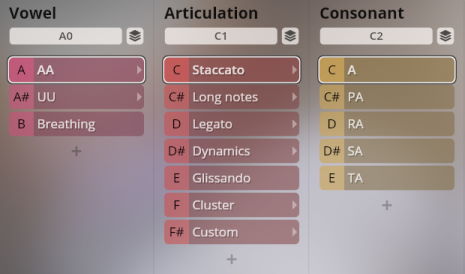
Long notes, Legato
Long notes and legato normal and espressivo, as well as with marcato attack on vowels and consonants. In addition, legato offers Performance trills.
- Normal/marcato: G1/G#1.
- Vibrato switch (ensembles): F2–G2, F5–G5 (basses).
- Vibrato crossfading (ensembles): Dim.Ctrl/C (MIDI CC 20).
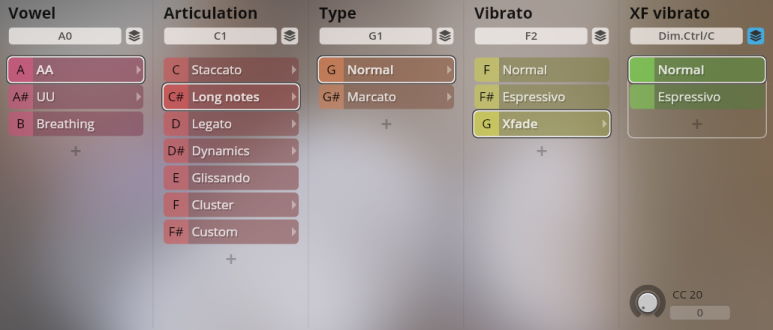
Marcato
Keystroke velocity determines the amount of marcato attack.
- Vowels and consonants: C2–E2 / C5–E5 (basses).
- Marcato attack: Dim.Ctrl/A (keystroke velocity).
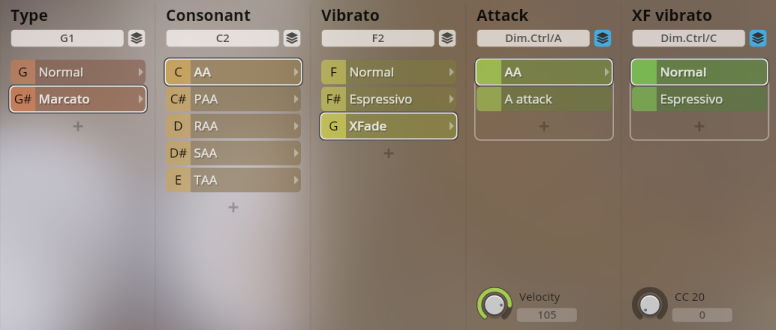
Legato: Performance trill
Normal/marcato/trill: G1–A1.
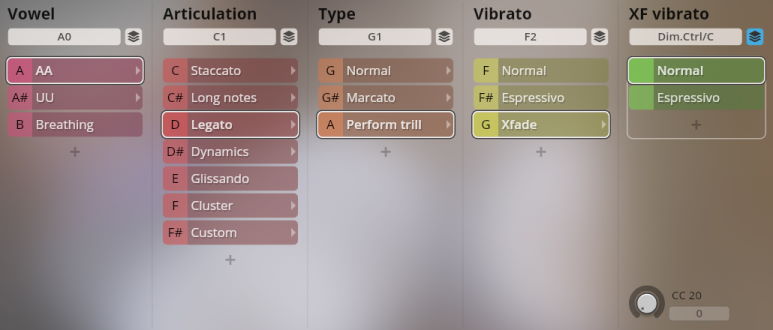
Dynamics
Sforzato, crescendo and diminuendo 2/3/4 seconds, and crescendo with marcato attack on vowels and consonants.
- Dynamics type: G1–A1.
- Length switches: F2–G2, F5–G5.
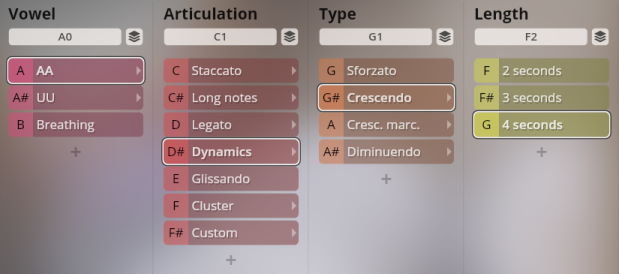
Crescendo marcato
Keystroke velocity determines the marcato attack amount.
- Vowels and consonants: C2–E2 / C5–E5 (basses).
- Marcato attack: Dim.Ctrl/A (keystroke velocity).
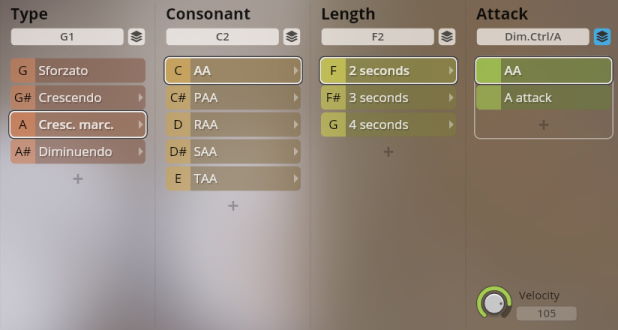
Glissando
Performance glissandos.
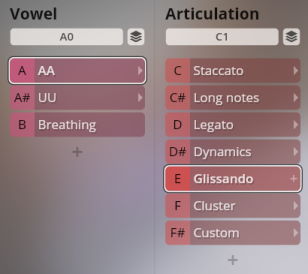
Cluster
Sustained and performance clusters.
- Cluster/performance cluster: G1/G2.
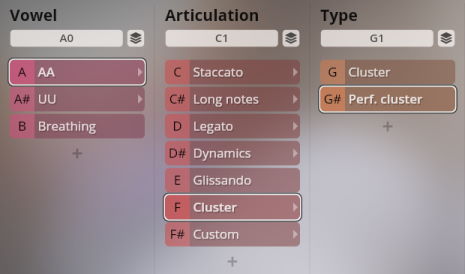
Female choir / Male choir
The female and male choirs have stacked ensembles with accordingly different ranges. Apart from that, articulations are the same as those of individual ensembles.
- Female choir range: E3–C6; clusters G4–A#5.
- Male choir range: C2–B4; clusters C2–A#4.
Full Choir
The full choir has the same articulations as the individual ensembles but lacks legato and glissando articulations – the legato slot therefore contains a copy of the long notes. The glissandos are replaced by “creepy” sustains.
- Range: C2–C6; cluster C2–A#5.
- Consonant keyswitches: C7–E7.
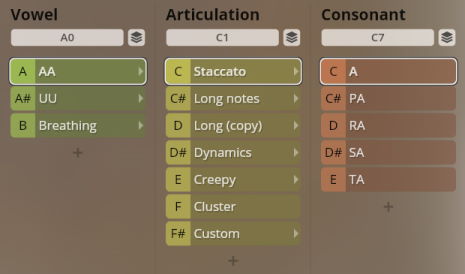
Creepy
“Creepy” sustains – female voices, male voices, and merged.
- Range: merged C2–C5; female E3–C5; male C2–C4.
- Merged/Female/Male: G1–A1.
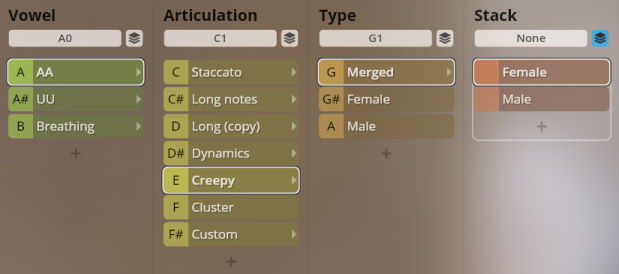
Bonus: Soprano choir with 32 singers
This special Preset contains the merged samples of our two soprano choir recordings, with long notes and legato on “AA” and “UU”, as well as breathing sounds.
- Range: A#3–C6.
- Long notes/legato: C#1/D1.
